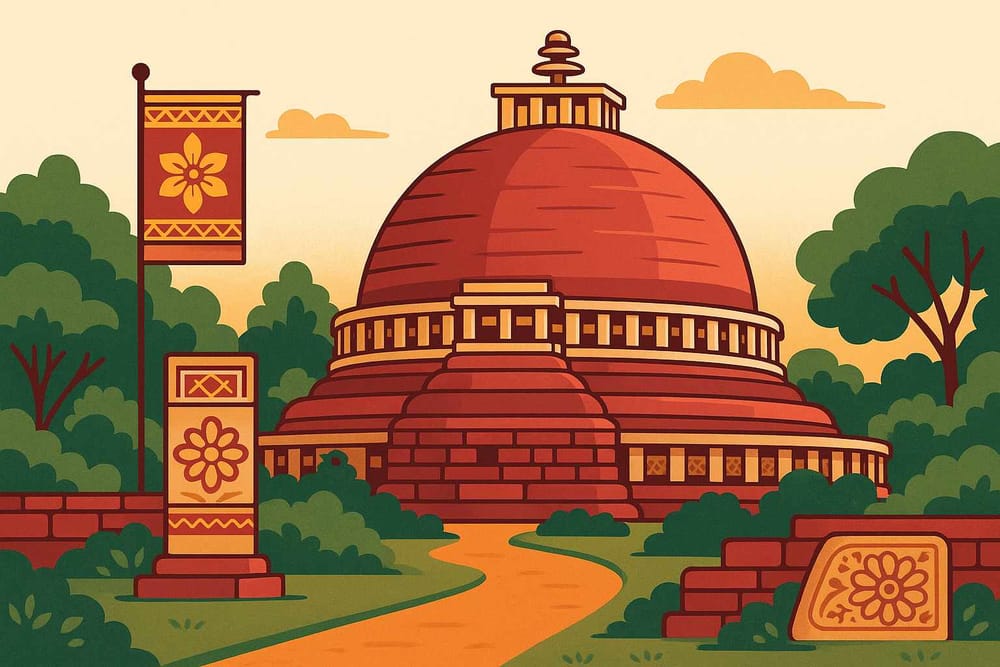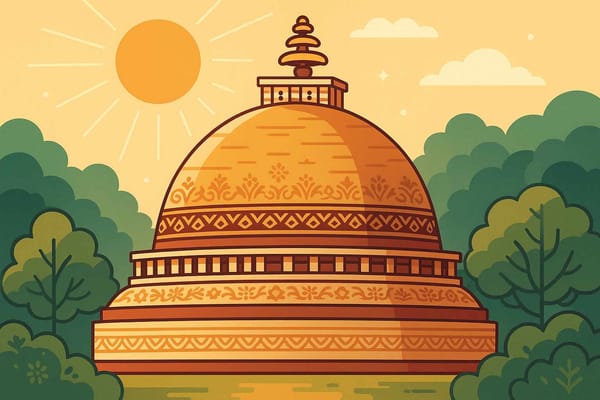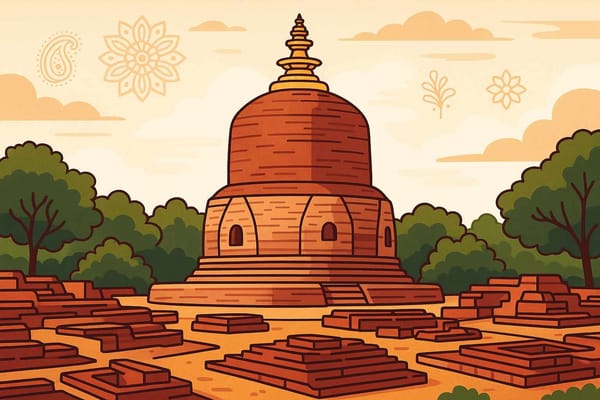
Dharmarajika Stupa: Time Travels Through Ancient History
Have you ever stood in a place so old that the silence itself seems to tell a story? A place where the wind carries faint echoes of ancient chants and the footsteps of countless pilgrims from centuries ago? That’s the feeling that washes over you when you learn about the Dharmarajika Stupa. It’s more than just a historical ruin; it’s a portal to a time when faith moved mountains and shaped empires. It’s a piece of our shared heritage that still beats with a quiet, spiritual heart.
The Heartbeat of an Emperor's Faith
The story of this magnificent stupa begins with a powerful transformation. Many wonder who built the Dharmarajika Stupa, and the answer lies with one of history's most remarkable rulers: Emperor Ashoka of the Mauryan Dynasty. In the 3rd century BCE, after the immense bloodshed of the Kalinga war, Ashoka’s heart turned towards the path of peace, towards the teachings of the Buddha. He became a 'Dharma Raja,' a righteous king, and his mission was to spread the message of compassion across his vast empire.
To do this, he commissioned the construction of stupas to house sacred relics of the Buddha. He chose Taxila for one of his most significant projects. Why Taxila? Because in ancient times, Taxila wasn't just a city; it was a vibrant crossroads of knowledge, culture, and trade. Nestled in what is now Pakistan, it was a melting pot where scholars from far and wide came to learn, making it the perfect ground to sow the seeds of Dharma. The stupa's very name, Dharmarajika, is a tribute to the ultimate Dharma Raja—the Buddha himself.
A Masterpiece Carved in Stone and Spirit
The architecture of the Dharmarajika Stupa is a lesson in spiritual symbolism. Its design is a beautiful example of early Buddhist craftsmanship, a physical representation of the cosmos. The massive, hemispherical dome, called the anda, rises towards the sky, symbolising the endless heavens. It rests on a circular platform, or medhi, which represents the earth. At its very core, protected deep within the structure, lay the relic chamber, which was built with the sacred purpose of enshrining holy relics of Lord Buddha, making the entire structure a focal point of immense spiritual energy.
What makes its architecture truly unique is the mesmerising blend of Indian and Greco-Roman artistic styles, a signature of the Gandhara region. The intricately carved railings and gateways tell stories from the Buddha's life. This artistic fusion blossomed further during the Kushan Empire, turning the stupa and its surroundings into a gallery of devotional art. Built from local schist stone, it has bravely weathered the storms of time, a silent witness to history's ebb and flow.
Echoes of Chants and Circumambulation
Imagine this place not as a silent ruin, but as a living, breathing centre of faith. The air would have been thick with the fragrance of incense and the sound of prayers. The Dharmarajika Stupa was designed for sacred rituals, most importantly the pradakshina, or circumambulation. Devotees would walk clockwise around the great dome, their minds focused in meditation, their hearts filled with reverence. This practice was a way to physically and spiritually align oneself with the universe and the teachings of the Buddha.
Surrounding the main stupa are smaller votive stupas and monastic cells, evidence of a thriving community of monks and pilgrims. It was a place for spiritual gatherings, for learning, and for finding peace. The stupa’s historical significance isn't just in its age or its builder, but in the millions of moments of devotion that it has silently absorbed over the centuries. It truly was a beacon of Buddhist heritage.
The Scars of Time and a Glorious Rediscovery
Like all great things, the stupa faced its share of trials. A severe earthquake in the 1st century AD caused significant damage, but the faithful repaired it. However, a more devastating blow came in the 5th century CE with the invasion of the White Huns, who rampaged through the region, destroying countless monasteries. The Dharmarajika Stupa was ravaged and eventually abandoned, falling into the quiet embrace of time.
For centuries, its glory lay buried, until it was rediscovered by archaeologists in the 19th and early 20th centuries, with systematic excavations led by Sir John Marshall. What they uncovered was a treasure trove—caskets containing relics, ancient coins, and inscriptions that helped piece together the story of this incredible monument. Today, as a UNESCO World Heritage Site, its legacy is protected for the world to see and cherish.
Yes, visitors can still explore the serene ruins of Dharmarajika Stupa today. Walking through the site is an unforgettable experience, a true journey through time that connects you to the soul of our ancient past. This feeling of walking on sacred ground isn't limited to Taxila; you can feel similar Udaipur's sacred echoes, reminding us that our spiritual heritage is a vast, interconnected tapestry spread across the subcontinent.
Find Your Connection with Bhaktilipi
If stories like that of the Dharmarajika Stupa stir something deep within your soul, then you have found a home at Bhaktilipi. We are a digital space dedicated to bringing these timeless tales of devotion and our rich heritage to you. We believe that understanding our past is the best way to enrich our present.
On our platform, you can gain deep knowledge about sacred sites, understand the meaning behind ancient rituals, and stay connected to your spiritual roots, all in one place. If you cherish authenticity and seek to bring the wisdom of our traditions into your modern life, Bhaktilipi is here to guide you. For all your spiritual needs, from authentic puja samagri to profound knowledge, explore our offerings at Bhaktilipi.in.
Stay connected with our community. Follow us on Facebook, Instagram, and YouTube for daily doses of inspiration and spiritual wisdom.
A Timeless Reminder of Our Shared Roots
The Dharmarajika Stupa is so much more than an archaeological marvel. It is a sacred thread connecting us to a shared heritage of peace, compassion, and profound wisdom. It reminds us that borders may change, but the roots of our culture run deep and wide. As we learn about its history and admire its artistry, we are reminded of the values that have guided countless generations.
Let us cherish this timeless treasure, for its story is our story. It is a testament to the enduring power of faith and a beacon of unity that continues to shine brightly through the ages.
A passionate group of people dedicated to preserving India's knowledge of Dharma, Karma, and Bhakti for ourselves and the world 🙏.
Comments
Related in

Dharmarajika Stupa - A Time Traveler's Exploration
Some places in the world don't just exist in space and time; they hold time within them. Standing before the great Dharmarajika Stupa in Taxila, Pakistan, you can feel the centuries fold into one another. It's as if the air itself is thick with ancient chants

Dharmarajika Stupa: Journey Through History
Some places in the world feel like they hold time within their very stones. Standing before them, you can almost hear the whispers of centuries past, the footsteps of pilgrims, and the chants of monks. The great Dharmarajika Stupa in Taxila is one such place. It’s more than just

The Mystical Aura of Dharmarajika- Time Reveals its Secrets
Some places in the world feel like they hold time within their very stones. They are not just historical sites; they are living testaments to faith, art, and human devotion. Imagine standing in the ancient city of Taxila, in present-day Pakistan, where the air itself seems to hum with stories
